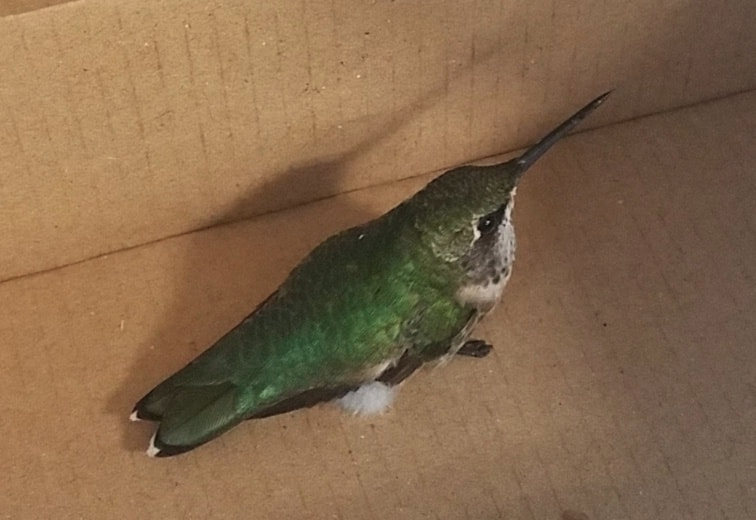
This young ruby-throated hummer was found in the road, laying on its side. A very lucky bird, because a kind person spotted him and brought him in for help. He was a young male hummer and pretty puffy, which means he was not feeling well.
Nothing seemed broken, and just hours later he was doing better and “helicoptering” a bit. That means he can just fly up and down and up and down but not fly all around like hummers should. His weight was just 3.7 grams.
Offering Native Plants
Ruby-throated hummingbirds have a tough time with migration when there are storms. One way to help is to plant native flowering plants that they will enjoy and fuel up on. No time to plant? Put them in pots for now and plant them in the ground later.
Native plants are the best investment for hummers and other birds, instead of feeders and they require very little maintenance once they are established. Native plants are the best to use to help wild birds survive.
Help Out with Insects
Hummingbirds eat a lot of small flying insects so you can also hang some sweet melon rinds to attract fruit flies. It is fun to watch them hawk tiny gnats and flies. If you have feeders, make sure you don’t use any red food coloring and clean them every few days depending on the heat.
The Danger of Sugar Water
If sugar water gets on a hummingbird’s feathers, the feathers will fall out. That is what happened to one intake, a ruby-throated hummingbird. A person found a hummer on the ground, kept it, and fed it sugar water for several days. Unfortunately, somehow it “fell” into the cup of sugar water as she was preparing it. The person said they immediately grabbed it out of the cup. When the bird was loosing its feathers, she called Help Wild Birds.
Beside missing feathers, the bird had an injured wing. It will take about three weeks for the missing feathers to grow back.

PLEASE do not get sugar water on hummingbirds. If you find a hummer and do give it sugar water to revive it, make sure you are careful not to let it drip on their feathers.
If you hand feed them, do not use any open containers. Don’t grease their feeder flowers or poles either to keep wasps or ants away. There are other things you can do to prevent wasps or ants at your feeders.
Birds need to keep their feathers in pristine working condition. Otherwise they may not be able to fly or be able to thermoregulate their body. Let’s try to #helpwildbirds and respect our winged jewels.
Should I leave my hummingbird feeders up? Will they not migrate unless I take them down? What can keep them from migrating?
As far as ruby-throated hummers go, it is better to leave feeders up providing they are kept clean (and have NO red food dye), as this will help the late migrants that may be passing through. Take them down around the first frost for your area. You never know; you may have a very late straggler. Our weather has been changing and seasons/bird migrations seem to be shifting.
Hummers will migrate when they have enough food and weather conditions are good to leave, even if you leave your feeders up. There may still be flowers everywhere and gnats/insects but they will migrate, it is ingrained in their DNA.
The birds at your feeders usually leave when they look “pregnant” with rounded bellies. They leave when they feel they have enough food to fly onward. So it is a myth that leaving the feeders up keeps them from migrating.
What can keep them from migrating? The weather can keep them from migrating. Or if a bird is sick it may not leave a reliable food source. But having a hummingbird feeder will not prevent a healthy hummer from it’s migration.
You can make your own hummingbird mixture of 1 part cane sugar dissolved in 4 parts water. Just remember to keep your feeders clean. That means you need to change out your sugar solution and clean your feeder every 3 or 4 days depending on the weather. We don’t want to make hummingbirds sick. Having two feeders and swapping them out makes that easy to do. Also look at how your feeder is designed – you can make cleaning easier with well designed feeders.

